HRMT3501: Comprehensive Essay on Compensation Systems Management
VerifiedAdded on 2023/01/19
|8
|1946
|58
Essay
AI Summary
This essay provides a detailed examination of compensation systems management, addressing key concepts such as compensation, compensation management, mergers, and downsizing. It defines and explains various incentive plans, including the Scanlon Plan, Rucker Plan, and Improshare Plan, highlighting their differences and applications. The essay further explores the distinctions between short-term and long-term incentives, emphasizing their impact on employee motivation and retention. It also discusses the significance of exit interviews, outlining the advantages they offer to management in understanding employee perspectives and improving workplace practices. The essay concludes by outlining the crucial steps involved in dismissing an employee professionally and ethically, along with the importance of pre-retirement counseling for both employees and the company, emphasizing its role in planning for retirement and retaining valuable talent.
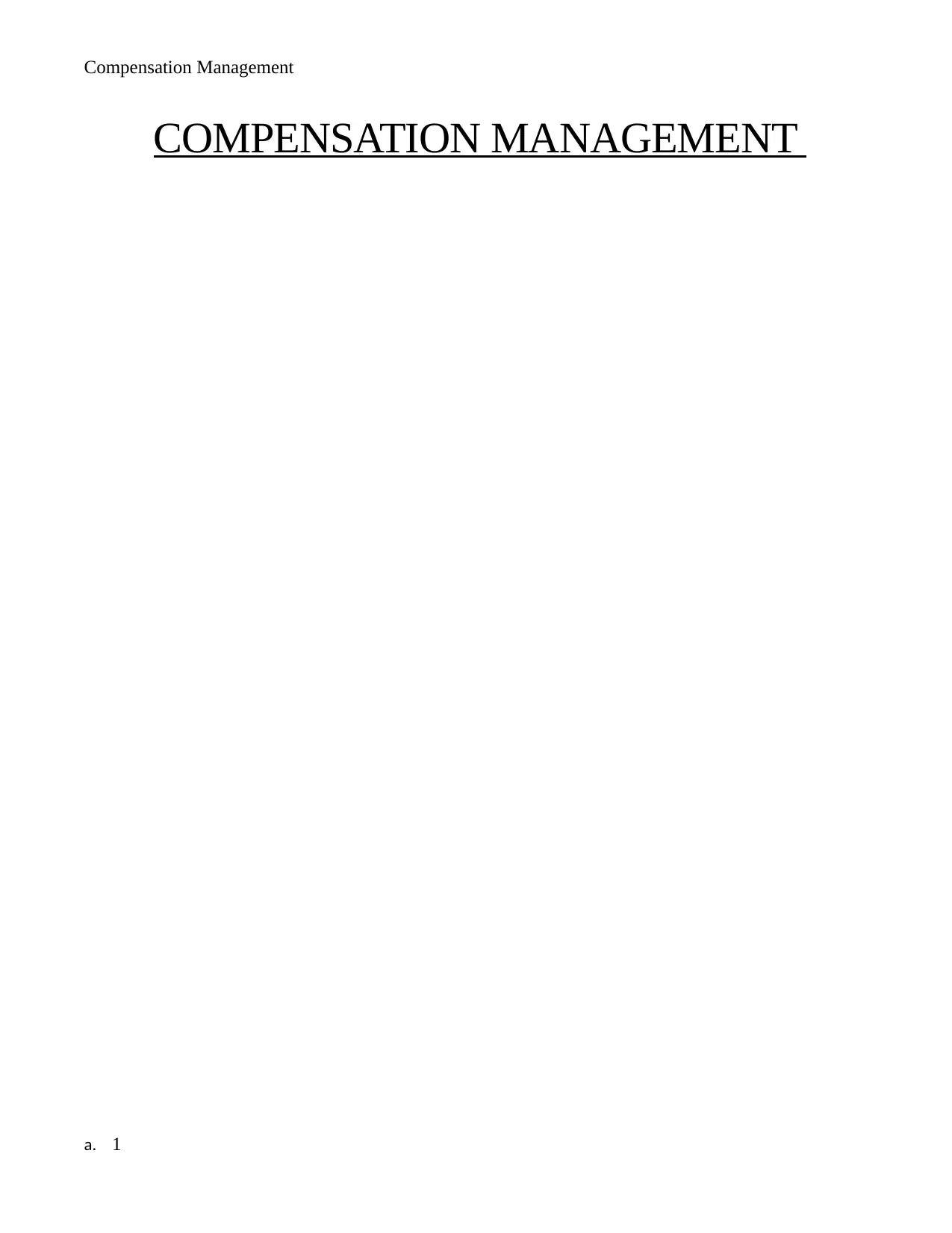
Compensation Management
COMPENSATION MANAGEMENT
a. 1
COMPENSATION MANAGEMENT
a. 1
Paraphrase This Document
Need a fresh take? Get an instant paraphrase of this document with our AI Paraphraser
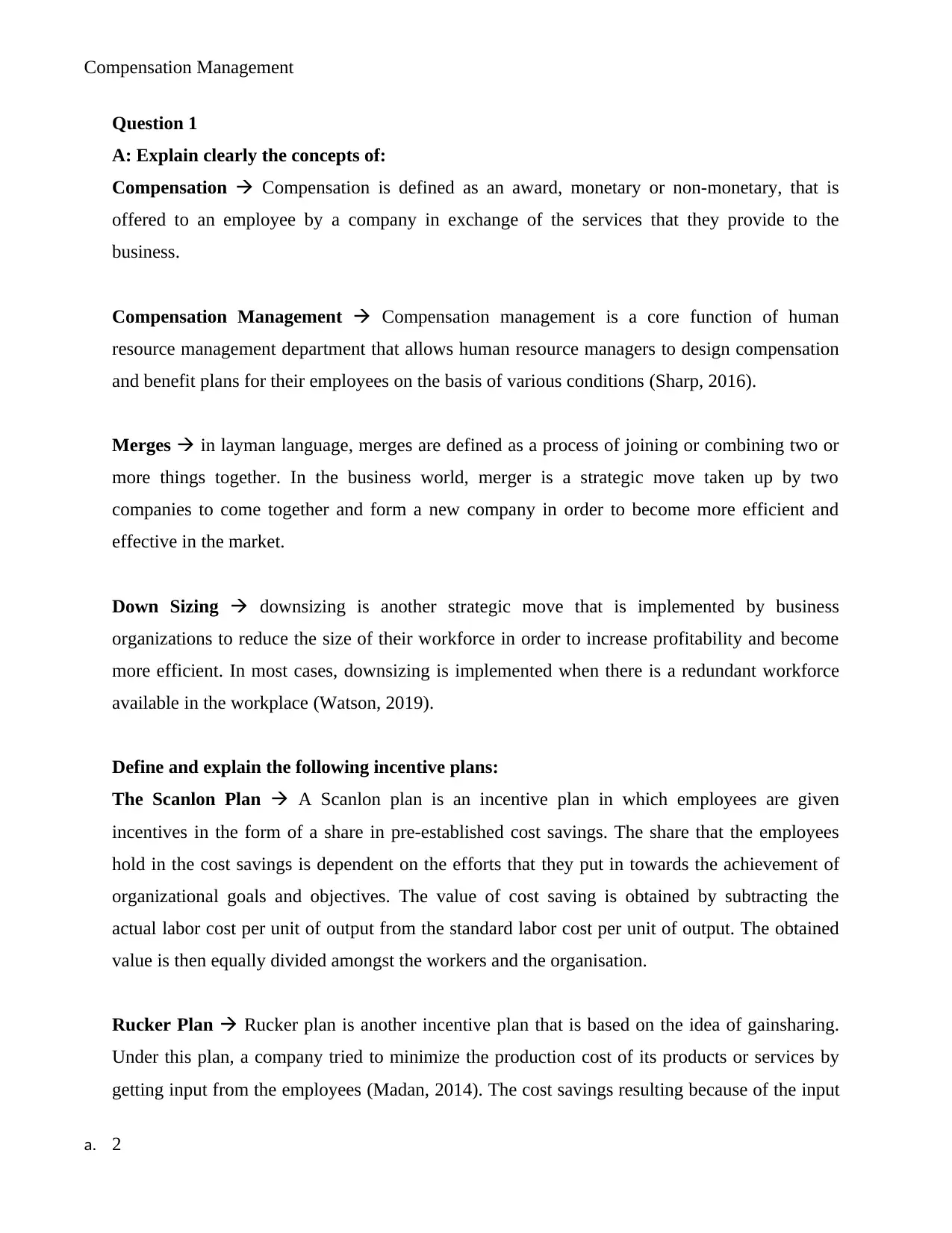
Compensation Management
Question 1
A: Explain clearly the concepts of:
Compensation Compensation is defined as an award, monetary or non-monetary, that is
offered to an employee by a company in exchange of the services that they provide to the
business.
Compensation Management Compensation management is a core function of human
resource management department that allows human resource managers to design compensation
and benefit plans for their employees on the basis of various conditions (Sharp, 2016).
Merges in layman language, merges are defined as a process of joining or combining two or
more things together. In the business world, merger is a strategic move taken up by two
companies to come together and form a new company in order to become more efficient and
effective in the market.
Down Sizing downsizing is another strategic move that is implemented by business
organizations to reduce the size of their workforce in order to increase profitability and become
more efficient. In most cases, downsizing is implemented when there is a redundant workforce
available in the workplace (Watson, 2019).
Define and explain the following incentive plans:
The Scanlon Plan A Scanlon plan is an incentive plan in which employees are given
incentives in the form of a share in pre-established cost savings. The share that the employees
hold in the cost savings is dependent on the efforts that they put in towards the achievement of
organizational goals and objectives. The value of cost saving is obtained by subtracting the
actual labor cost per unit of output from the standard labor cost per unit of output. The obtained
value is then equally divided amongst the workers and the organisation.
Rucker Plan Rucker plan is another incentive plan that is based on the idea of gainsharing.
Under this plan, a company tried to minimize the production cost of its products or services by
getting input from the employees (Madan, 2014). The cost savings resulting because of the input
a. 2
Question 1
A: Explain clearly the concepts of:
Compensation Compensation is defined as an award, monetary or non-monetary, that is
offered to an employee by a company in exchange of the services that they provide to the
business.
Compensation Management Compensation management is a core function of human
resource management department that allows human resource managers to design compensation
and benefit plans for their employees on the basis of various conditions (Sharp, 2016).
Merges in layman language, merges are defined as a process of joining or combining two or
more things together. In the business world, merger is a strategic move taken up by two
companies to come together and form a new company in order to become more efficient and
effective in the market.
Down Sizing downsizing is another strategic move that is implemented by business
organizations to reduce the size of their workforce in order to increase profitability and become
more efficient. In most cases, downsizing is implemented when there is a redundant workforce
available in the workplace (Watson, 2019).
Define and explain the following incentive plans:
The Scanlon Plan A Scanlon plan is an incentive plan in which employees are given
incentives in the form of a share in pre-established cost savings. The share that the employees
hold in the cost savings is dependent on the efforts that they put in towards the achievement of
organizational goals and objectives. The value of cost saving is obtained by subtracting the
actual labor cost per unit of output from the standard labor cost per unit of output. The obtained
value is then equally divided amongst the workers and the organisation.
Rucker Plan Rucker plan is another incentive plan that is based on the idea of gainsharing.
Under this plan, a company tried to minimize the production cost of its products or services by
getting input from the employees (Madan, 2014). The cost savings resulting because of the input
a. 2
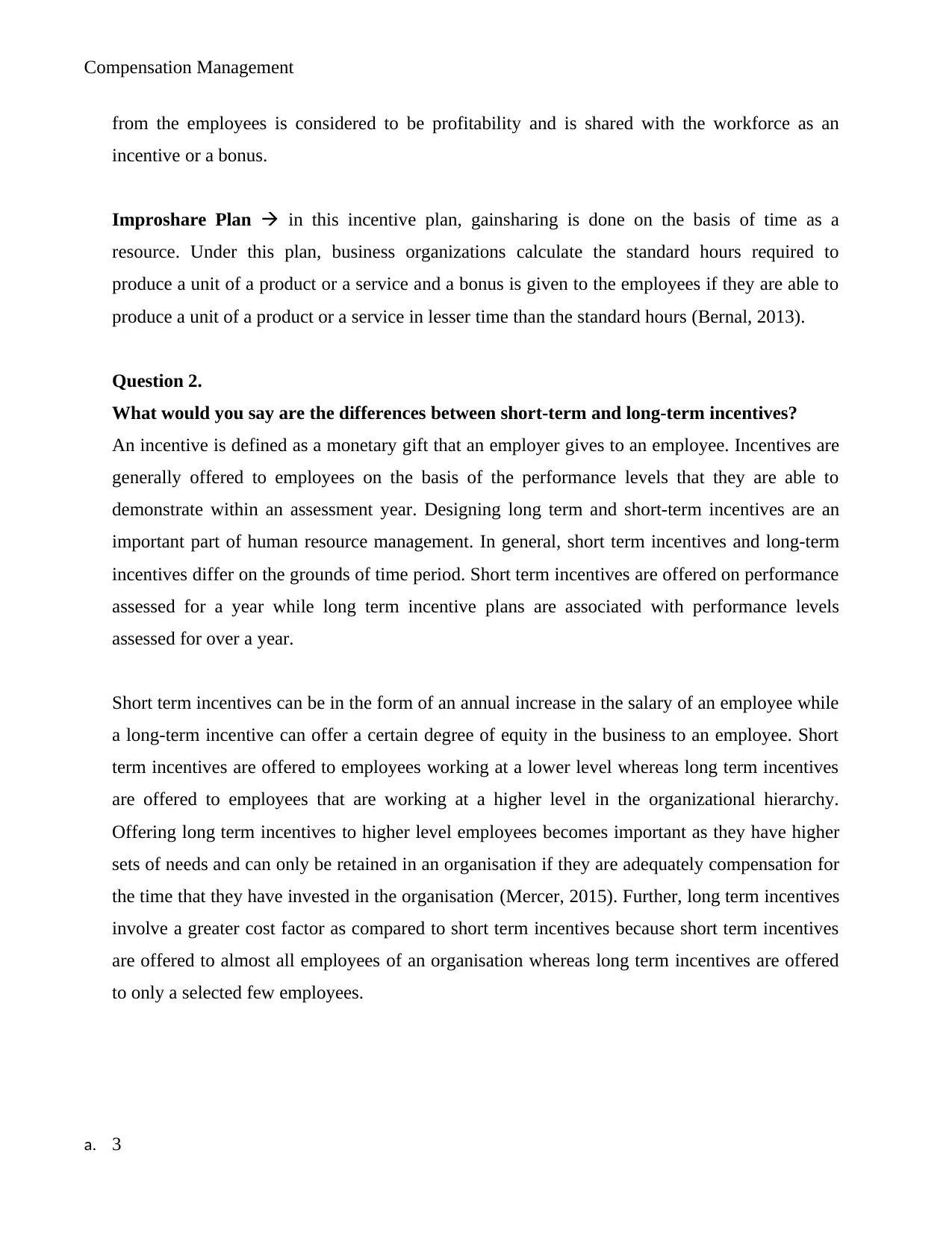
Compensation Management
from the employees is considered to be profitability and is shared with the workforce as an
incentive or a bonus.
Improshare Plan in this incentive plan, gainsharing is done on the basis of time as a
resource. Under this plan, business organizations calculate the standard hours required to
produce a unit of a product or a service and a bonus is given to the employees if they are able to
produce a unit of a product or a service in lesser time than the standard hours (Bernal, 2013).
Question 2.
What would you say are the differences between short-term and long-term incentives?
An incentive is defined as a monetary gift that an employer gives to an employee. Incentives are
generally offered to employees on the basis of the performance levels that they are able to
demonstrate within an assessment year. Designing long term and short-term incentives are an
important part of human resource management. In general, short term incentives and long-term
incentives differ on the grounds of time period. Short term incentives are offered on performance
assessed for a year while long term incentive plans are associated with performance levels
assessed for over a year.
Short term incentives can be in the form of an annual increase in the salary of an employee while
a long-term incentive can offer a certain degree of equity in the business to an employee. Short
term incentives are offered to employees working at a lower level whereas long term incentives
are offered to employees that are working at a higher level in the organizational hierarchy.
Offering long term incentives to higher level employees becomes important as they have higher
sets of needs and can only be retained in an organisation if they are adequately compensation for
the time that they have invested in the organisation (Mercer, 2015). Further, long term incentives
involve a greater cost factor as compared to short term incentives because short term incentives
are offered to almost all employees of an organisation whereas long term incentives are offered
to only a selected few employees.
a. 3
from the employees is considered to be profitability and is shared with the workforce as an
incentive or a bonus.
Improshare Plan in this incentive plan, gainsharing is done on the basis of time as a
resource. Under this plan, business organizations calculate the standard hours required to
produce a unit of a product or a service and a bonus is given to the employees if they are able to
produce a unit of a product or a service in lesser time than the standard hours (Bernal, 2013).
Question 2.
What would you say are the differences between short-term and long-term incentives?
An incentive is defined as a monetary gift that an employer gives to an employee. Incentives are
generally offered to employees on the basis of the performance levels that they are able to
demonstrate within an assessment year. Designing long term and short-term incentives are an
important part of human resource management. In general, short term incentives and long-term
incentives differ on the grounds of time period. Short term incentives are offered on performance
assessed for a year while long term incentive plans are associated with performance levels
assessed for over a year.
Short term incentives can be in the form of an annual increase in the salary of an employee while
a long-term incentive can offer a certain degree of equity in the business to an employee. Short
term incentives are offered to employees working at a lower level whereas long term incentives
are offered to employees that are working at a higher level in the organizational hierarchy.
Offering long term incentives to higher level employees becomes important as they have higher
sets of needs and can only be retained in an organisation if they are adequately compensation for
the time that they have invested in the organisation (Mercer, 2015). Further, long term incentives
involve a greater cost factor as compared to short term incentives because short term incentives
are offered to almost all employees of an organisation whereas long term incentives are offered
to only a selected few employees.
a. 3
⊘ This is a preview!⊘
Do you want full access?
Subscribe today to unlock all pages.

Trusted by 1+ million students worldwide
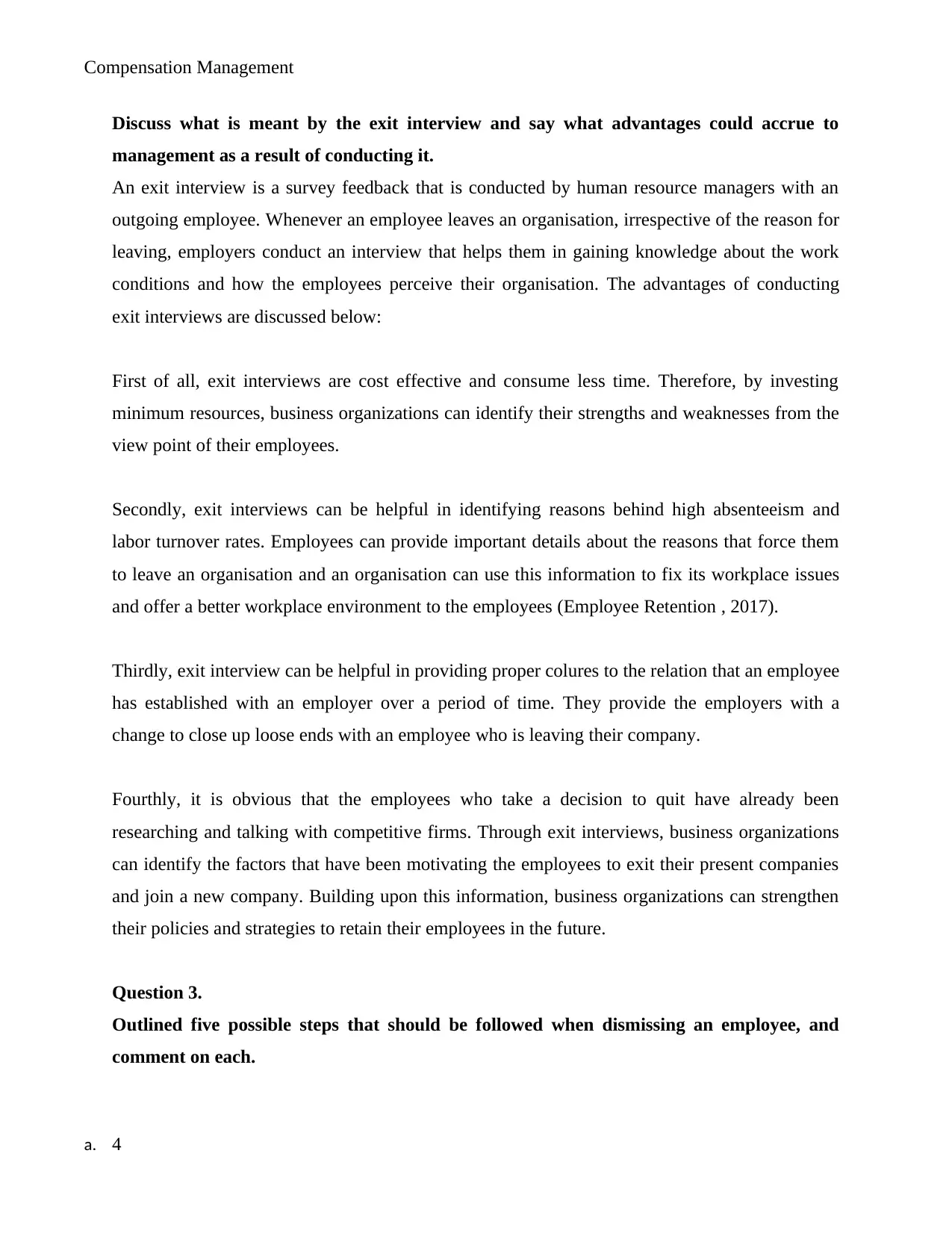
Compensation Management
Discuss what is meant by the exit interview and say what advantages could accrue to
management as a result of conducting it.
An exit interview is a survey feedback that is conducted by human resource managers with an
outgoing employee. Whenever an employee leaves an organisation, irrespective of the reason for
leaving, employers conduct an interview that helps them in gaining knowledge about the work
conditions and how the employees perceive their organisation. The advantages of conducting
exit interviews are discussed below:
First of all, exit interviews are cost effective and consume less time. Therefore, by investing
minimum resources, business organizations can identify their strengths and weaknesses from the
view point of their employees.
Secondly, exit interviews can be helpful in identifying reasons behind high absenteeism and
labor turnover rates. Employees can provide important details about the reasons that force them
to leave an organisation and an organisation can use this information to fix its workplace issues
and offer a better workplace environment to the employees (Employee Retention , 2017).
Thirdly, exit interview can be helpful in providing proper colures to the relation that an employee
has established with an employer over a period of time. They provide the employers with a
change to close up loose ends with an employee who is leaving their company.
Fourthly, it is obvious that the employees who take a decision to quit have already been
researching and talking with competitive firms. Through exit interviews, business organizations
can identify the factors that have been motivating the employees to exit their present companies
and join a new company. Building upon this information, business organizations can strengthen
their policies and strategies to retain their employees in the future.
Question 3.
Outlined five possible steps that should be followed when dismissing an employee, and
comment on each.
a. 4
Discuss what is meant by the exit interview and say what advantages could accrue to
management as a result of conducting it.
An exit interview is a survey feedback that is conducted by human resource managers with an
outgoing employee. Whenever an employee leaves an organisation, irrespective of the reason for
leaving, employers conduct an interview that helps them in gaining knowledge about the work
conditions and how the employees perceive their organisation. The advantages of conducting
exit interviews are discussed below:
First of all, exit interviews are cost effective and consume less time. Therefore, by investing
minimum resources, business organizations can identify their strengths and weaknesses from the
view point of their employees.
Secondly, exit interviews can be helpful in identifying reasons behind high absenteeism and
labor turnover rates. Employees can provide important details about the reasons that force them
to leave an organisation and an organisation can use this information to fix its workplace issues
and offer a better workplace environment to the employees (Employee Retention , 2017).
Thirdly, exit interview can be helpful in providing proper colures to the relation that an employee
has established with an employer over a period of time. They provide the employers with a
change to close up loose ends with an employee who is leaving their company.
Fourthly, it is obvious that the employees who take a decision to quit have already been
researching and talking with competitive firms. Through exit interviews, business organizations
can identify the factors that have been motivating the employees to exit their present companies
and join a new company. Building upon this information, business organizations can strengthen
their policies and strategies to retain their employees in the future.
Question 3.
Outlined five possible steps that should be followed when dismissing an employee, and
comment on each.
a. 4
Paraphrase This Document
Need a fresh take? Get an instant paraphrase of this document with our AI Paraphraser
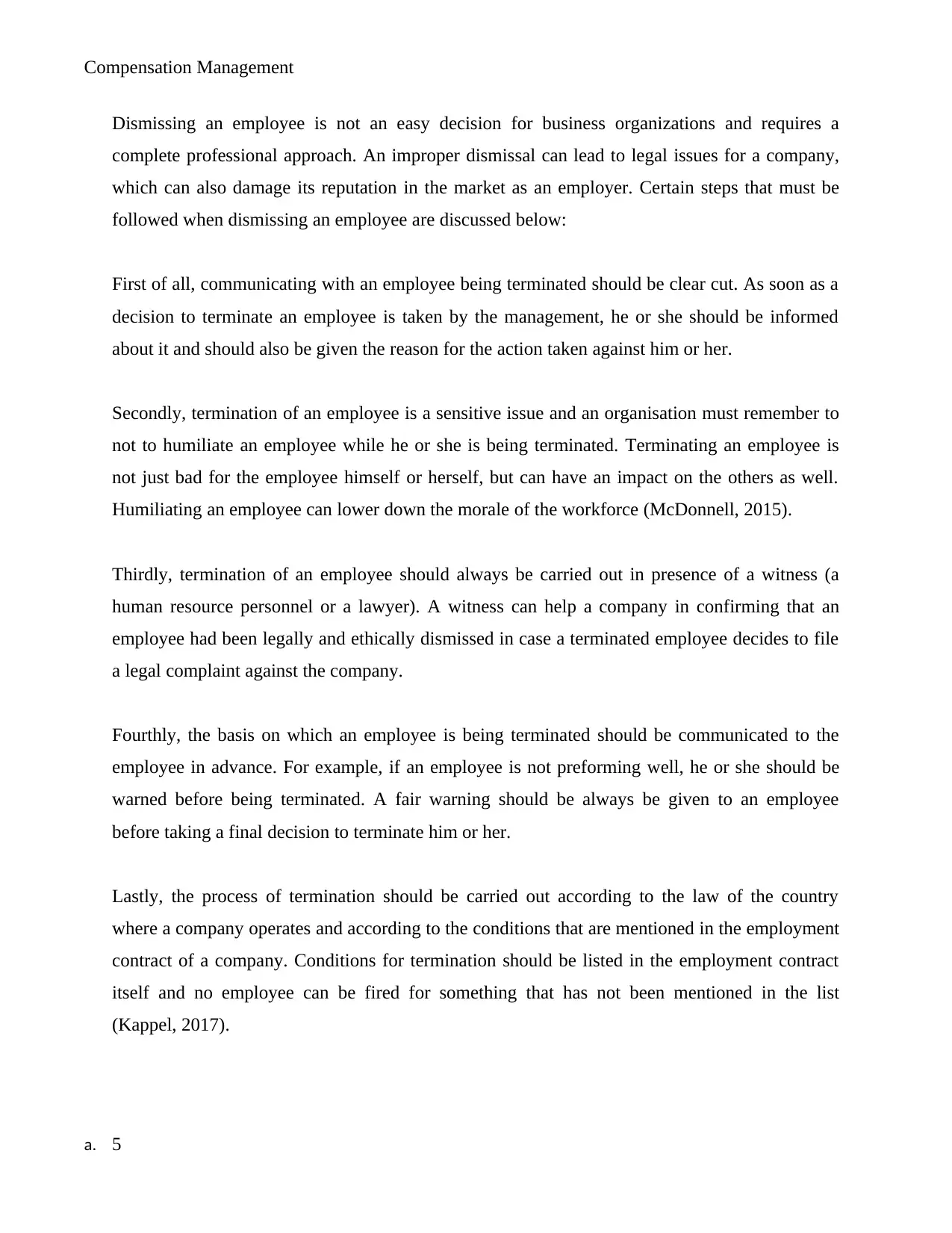
Compensation Management
Dismissing an employee is not an easy decision for business organizations and requires a
complete professional approach. An improper dismissal can lead to legal issues for a company,
which can also damage its reputation in the market as an employer. Certain steps that must be
followed when dismissing an employee are discussed below:
First of all, communicating with an employee being terminated should be clear cut. As soon as a
decision to terminate an employee is taken by the management, he or she should be informed
about it and should also be given the reason for the action taken against him or her.
Secondly, termination of an employee is a sensitive issue and an organisation must remember to
not to humiliate an employee while he or she is being terminated. Terminating an employee is
not just bad for the employee himself or herself, but can have an impact on the others as well.
Humiliating an employee can lower down the morale of the workforce (McDonnell, 2015).
Thirdly, termination of an employee should always be carried out in presence of a witness (a
human resource personnel or a lawyer). A witness can help a company in confirming that an
employee had been legally and ethically dismissed in case a terminated employee decides to file
a legal complaint against the company.
Fourthly, the basis on which an employee is being terminated should be communicated to the
employee in advance. For example, if an employee is not preforming well, he or she should be
warned before being terminated. A fair warning should be always be given to an employee
before taking a final decision to terminate him or her.
Lastly, the process of termination should be carried out according to the law of the country
where a company operates and according to the conditions that are mentioned in the employment
contract of a company. Conditions for termination should be listed in the employment contract
itself and no employee can be fired for something that has not been mentioned in the list
(Kappel, 2017).
a. 5
Dismissing an employee is not an easy decision for business organizations and requires a
complete professional approach. An improper dismissal can lead to legal issues for a company,
which can also damage its reputation in the market as an employer. Certain steps that must be
followed when dismissing an employee are discussed below:
First of all, communicating with an employee being terminated should be clear cut. As soon as a
decision to terminate an employee is taken by the management, he or she should be informed
about it and should also be given the reason for the action taken against him or her.
Secondly, termination of an employee is a sensitive issue and an organisation must remember to
not to humiliate an employee while he or she is being terminated. Terminating an employee is
not just bad for the employee himself or herself, but can have an impact on the others as well.
Humiliating an employee can lower down the morale of the workforce (McDonnell, 2015).
Thirdly, termination of an employee should always be carried out in presence of a witness (a
human resource personnel or a lawyer). A witness can help a company in confirming that an
employee had been legally and ethically dismissed in case a terminated employee decides to file
a legal complaint against the company.
Fourthly, the basis on which an employee is being terminated should be communicated to the
employee in advance. For example, if an employee is not preforming well, he or she should be
warned before being terminated. A fair warning should be always be given to an employee
before taking a final decision to terminate him or her.
Lastly, the process of termination should be carried out according to the law of the country
where a company operates and according to the conditions that are mentioned in the employment
contract of a company. Conditions for termination should be listed in the employment contract
itself and no employee can be fired for something that has not been mentioned in the list
(Kappel, 2017).
a. 5
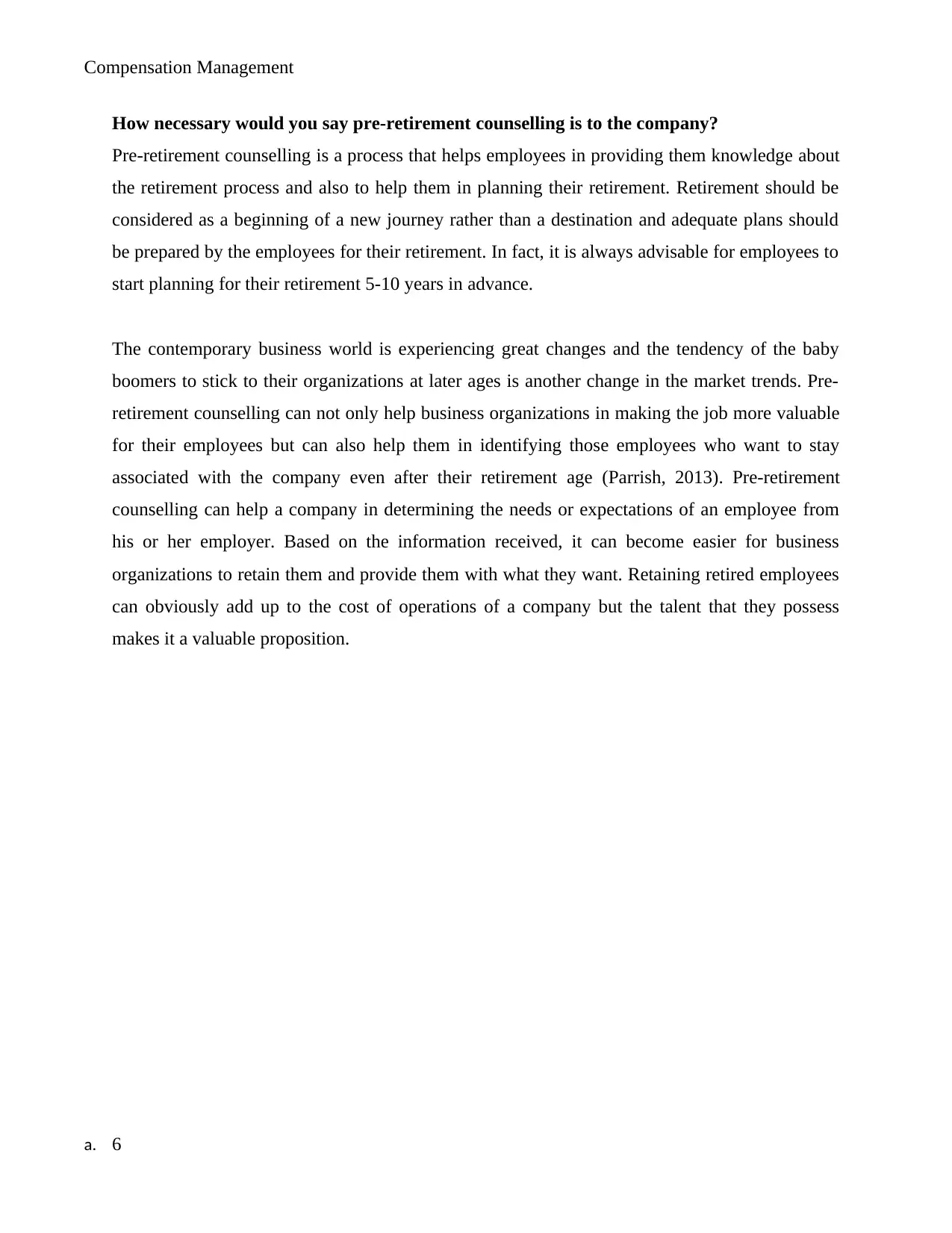
Compensation Management
How necessary would you say pre-retirement counselling is to the company?
Pre-retirement counselling is a process that helps employees in providing them knowledge about
the retirement process and also to help them in planning their retirement. Retirement should be
considered as a beginning of a new journey rather than a destination and adequate plans should
be prepared by the employees for their retirement. In fact, it is always advisable for employees to
start planning for their retirement 5-10 years in advance.
The contemporary business world is experiencing great changes and the tendency of the baby
boomers to stick to their organizations at later ages is another change in the market trends. Pre-
retirement counselling can not only help business organizations in making the job more valuable
for their employees but can also help them in identifying those employees who want to stay
associated with the company even after their retirement age (Parrish, 2013). Pre-retirement
counselling can help a company in determining the needs or expectations of an employee from
his or her employer. Based on the information received, it can become easier for business
organizations to retain them and provide them with what they want. Retaining retired employees
can obviously add up to the cost of operations of a company but the talent that they possess
makes it a valuable proposition.
a. 6
How necessary would you say pre-retirement counselling is to the company?
Pre-retirement counselling is a process that helps employees in providing them knowledge about
the retirement process and also to help them in planning their retirement. Retirement should be
considered as a beginning of a new journey rather than a destination and adequate plans should
be prepared by the employees for their retirement. In fact, it is always advisable for employees to
start planning for their retirement 5-10 years in advance.
The contemporary business world is experiencing great changes and the tendency of the baby
boomers to stick to their organizations at later ages is another change in the market trends. Pre-
retirement counselling can not only help business organizations in making the job more valuable
for their employees but can also help them in identifying those employees who want to stay
associated with the company even after their retirement age (Parrish, 2013). Pre-retirement
counselling can help a company in determining the needs or expectations of an employee from
his or her employer. Based on the information received, it can become easier for business
organizations to retain them and provide them with what they want. Retaining retired employees
can obviously add up to the cost of operations of a company but the talent that they possess
makes it a valuable proposition.
a. 6
⊘ This is a preview!⊘
Do you want full access?
Subscribe today to unlock all pages.

Trusted by 1+ million students worldwide
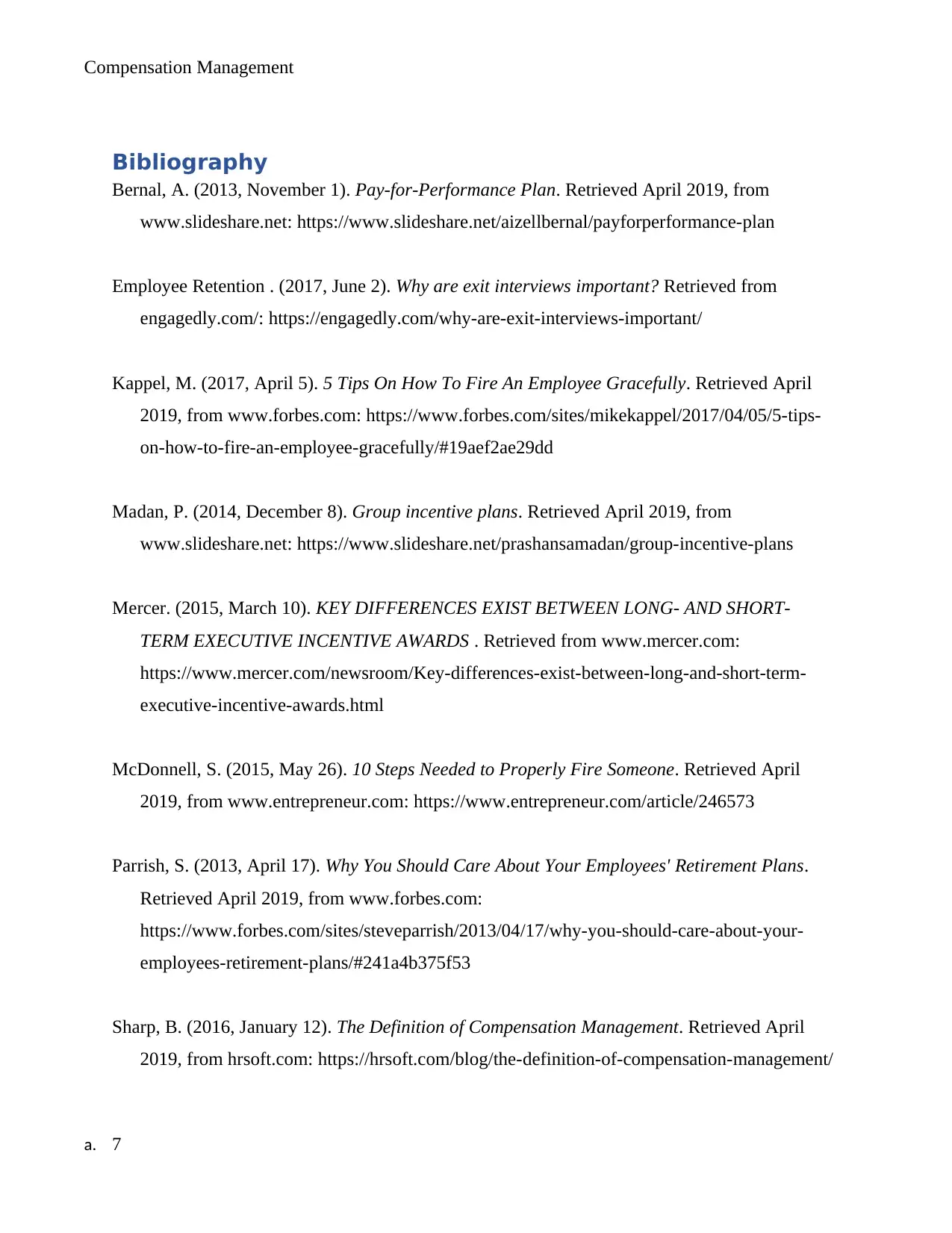
Compensation Management
Bibliography
Bernal, A. (2013, November 1). Pay-for-Performance Plan. Retrieved April 2019, from
www.slideshare.net: https://www.slideshare.net/aizellbernal/payforperformance-plan
Employee Retention . (2017, June 2). Why are exit interviews important? Retrieved from
engagedly.com/: https://engagedly.com/why-are-exit-interviews-important/
Kappel, M. (2017, April 5). 5 Tips On How To Fire An Employee Gracefully. Retrieved April
2019, from www.forbes.com: https://www.forbes.com/sites/mikekappel/2017/04/05/5-tips-
on-how-to-fire-an-employee-gracefully/#19aef2ae29dd
Madan, P. (2014, December 8). Group incentive plans. Retrieved April 2019, from
www.slideshare.net: https://www.slideshare.net/prashansamadan/group-incentive-plans
Mercer. (2015, March 10). KEY DIFFERENCES EXIST BETWEEN LONG- AND SHORT-
TERM EXECUTIVE INCENTIVE AWARDS . Retrieved from www.mercer.com:
https://www.mercer.com/newsroom/Key-differences-exist-between-long-and-short-term-
executive-incentive-awards.html
McDonnell, S. (2015, May 26). 10 Steps Needed to Properly Fire Someone. Retrieved April
2019, from www.entrepreneur.com: https://www.entrepreneur.com/article/246573
Parrish, S. (2013, April 17). Why You Should Care About Your Employees' Retirement Plans.
Retrieved April 2019, from www.forbes.com:
https://www.forbes.com/sites/steveparrish/2013/04/17/why-you-should-care-about-your-
employees-retirement-plans/#241a4b375f53
Sharp, B. (2016, January 12). The Definition of Compensation Management. Retrieved April
2019, from hrsoft.com: https://hrsoft.com/blog/the-definition-of-compensation-management/
a. 7
Bibliography
Bernal, A. (2013, November 1). Pay-for-Performance Plan. Retrieved April 2019, from
www.slideshare.net: https://www.slideshare.net/aizellbernal/payforperformance-plan
Employee Retention . (2017, June 2). Why are exit interviews important? Retrieved from
engagedly.com/: https://engagedly.com/why-are-exit-interviews-important/
Kappel, M. (2017, April 5). 5 Tips On How To Fire An Employee Gracefully. Retrieved April
2019, from www.forbes.com: https://www.forbes.com/sites/mikekappel/2017/04/05/5-tips-
on-how-to-fire-an-employee-gracefully/#19aef2ae29dd
Madan, P. (2014, December 8). Group incentive plans. Retrieved April 2019, from
www.slideshare.net: https://www.slideshare.net/prashansamadan/group-incentive-plans
Mercer. (2015, March 10). KEY DIFFERENCES EXIST BETWEEN LONG- AND SHORT-
TERM EXECUTIVE INCENTIVE AWARDS . Retrieved from www.mercer.com:
https://www.mercer.com/newsroom/Key-differences-exist-between-long-and-short-term-
executive-incentive-awards.html
McDonnell, S. (2015, May 26). 10 Steps Needed to Properly Fire Someone. Retrieved April
2019, from www.entrepreneur.com: https://www.entrepreneur.com/article/246573
Parrish, S. (2013, April 17). Why You Should Care About Your Employees' Retirement Plans.
Retrieved April 2019, from www.forbes.com:
https://www.forbes.com/sites/steveparrish/2013/04/17/why-you-should-care-about-your-
employees-retirement-plans/#241a4b375f53
Sharp, B. (2016, January 12). The Definition of Compensation Management. Retrieved April
2019, from hrsoft.com: https://hrsoft.com/blog/the-definition-of-compensation-management/
a. 7
Paraphrase This Document
Need a fresh take? Get an instant paraphrase of this document with our AI Paraphraser

Compensation Management
Watson, C. (2019, January 28). What Is the Meaning of Downsizing? Retrieved April 2019, from
Chron.com: https://work.chron.com/meaning-downsizing-6715.html
a. 8
Watson, C. (2019, January 28). What Is the Meaning of Downsizing? Retrieved April 2019, from
Chron.com: https://work.chron.com/meaning-downsizing-6715.html
a. 8
1 out of 8
Related Documents
Your All-in-One AI-Powered Toolkit for Academic Success.
+13062052269
info@desklib.com
Available 24*7 on WhatsApp / Email
![[object Object]](/_next/static/media/star-bottom.7253800d.svg)
Unlock your academic potential
Copyright © 2020–2025 A2Z Services. All Rights Reserved. Developed and managed by ZUCOL.





